Slide 1 — 1 Chapter 1 Accounting






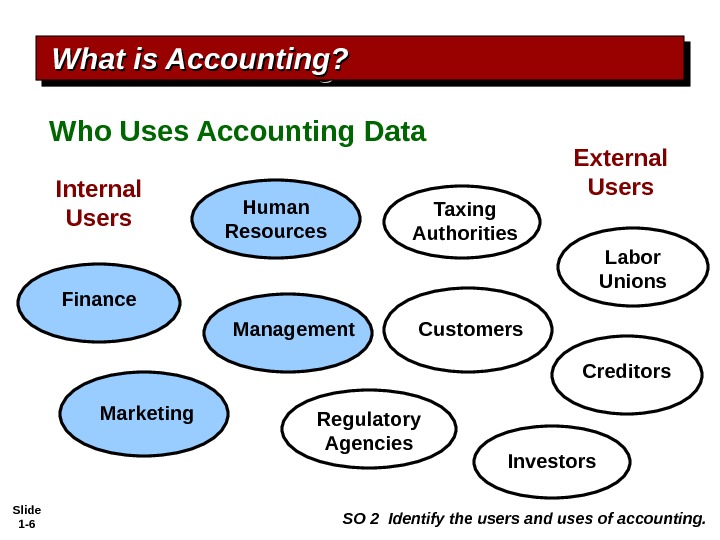


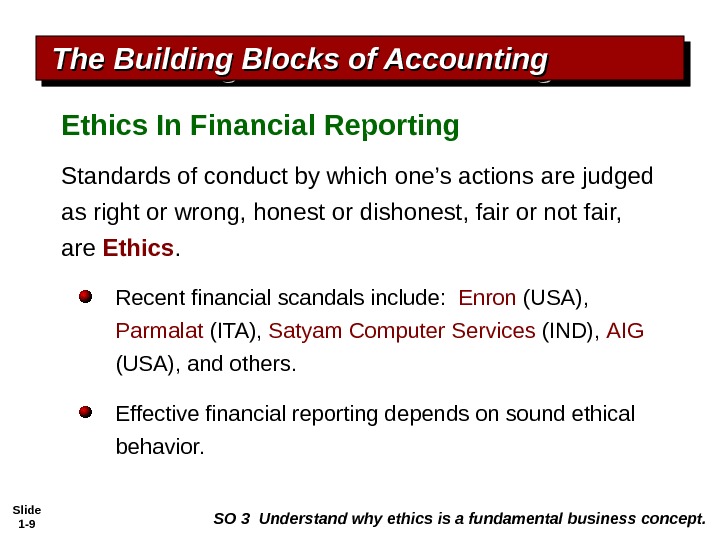





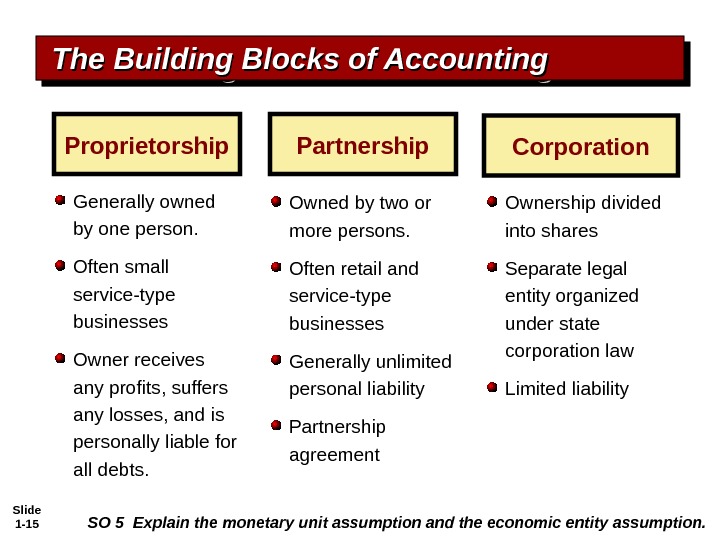



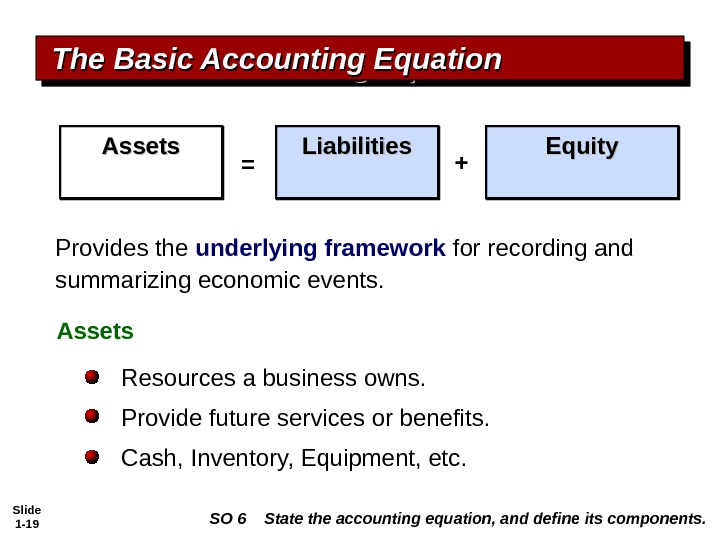
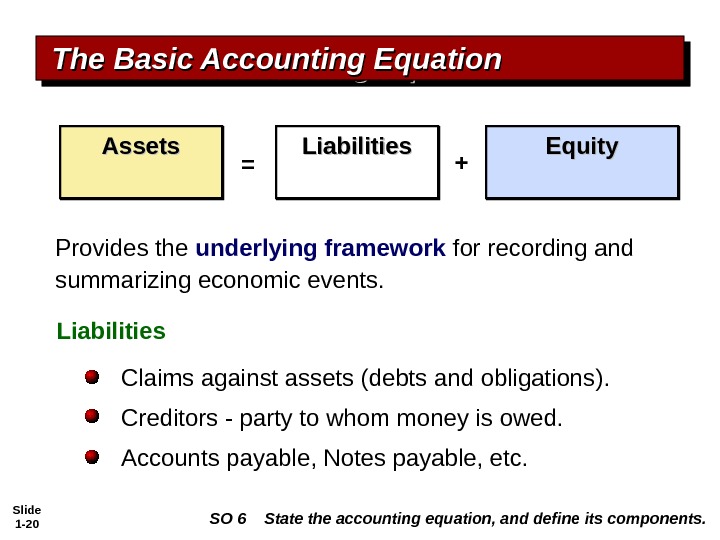
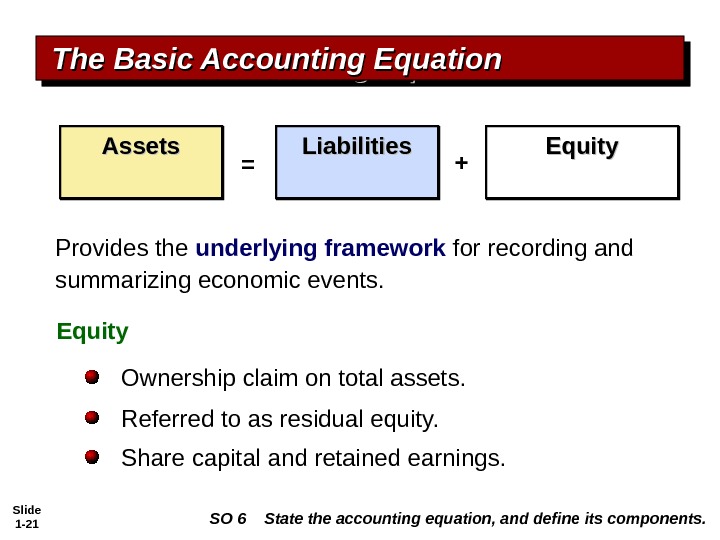


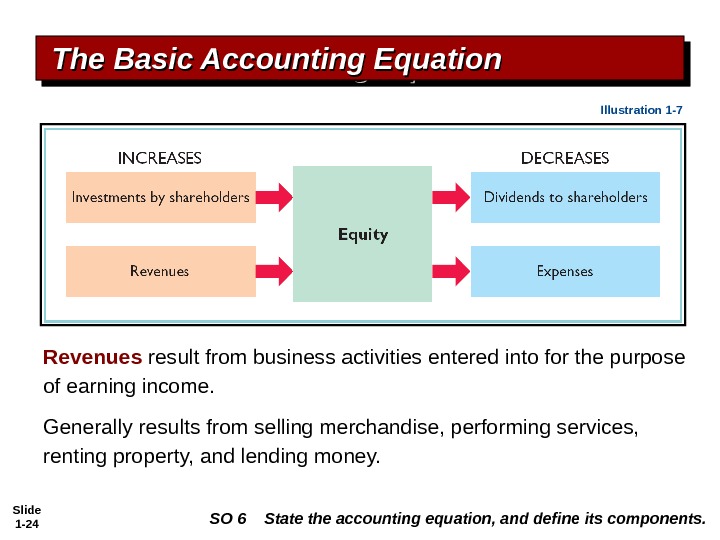



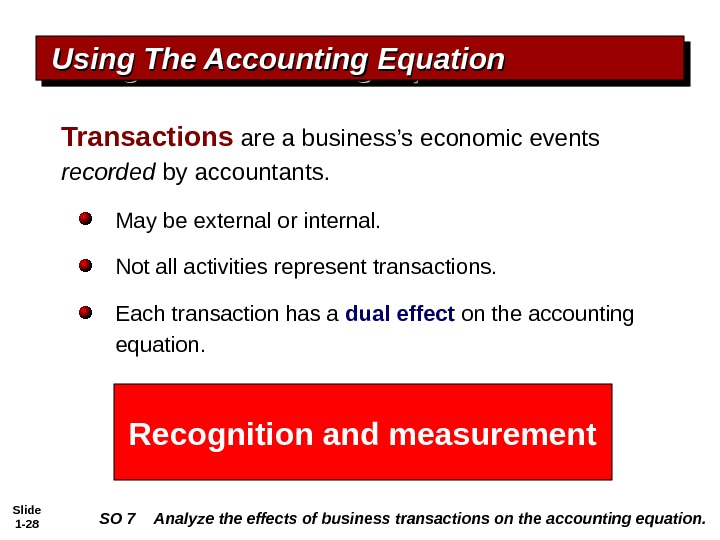













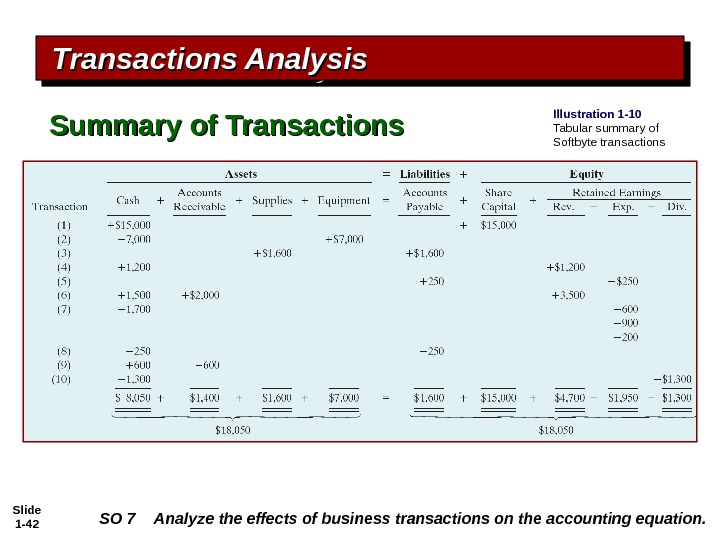


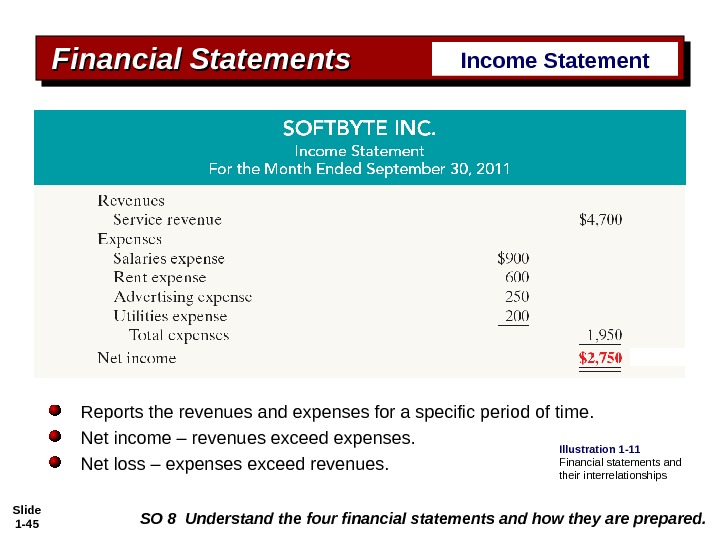





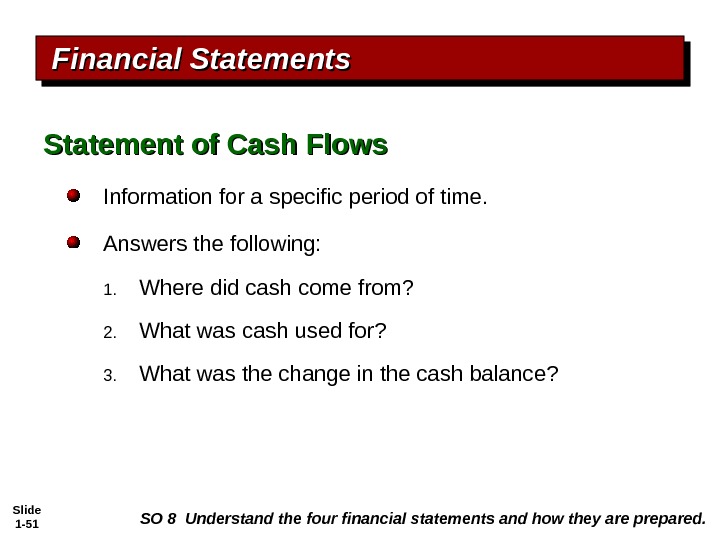

- Размер: 2.2 Mегабайта
- Количество слайдов: 52
Описание презентации Slide 1 — 1 Chapter 1 Accounting по слайдам
 Slide 1 — 1 Chapter 1 Accounting in Action
Slide 1 — 1 Chapter 1 Accounting in Action
 Slide 1 — 2 1. Explain what accounting is. 2. Identify the users and uses of accounting. 3. Understand why ethics is a fundamental business concept. 4. Explain accounting standards and the measurement principles. 5. Explain the monetary unit assumption and the economic entity assumption. 6. State the accounting equation, and define its components. 7. Analyze the effects of business transactions on the accounting equation. 8. Understand the four financial statements and how they are prepared. Study Objectives
Slide 1 — 2 1. Explain what accounting is. 2. Identify the users and uses of accounting. 3. Understand why ethics is a fundamental business concept. 4. Explain accounting standards and the measurement principles. 5. Explain the monetary unit assumption and the economic entity assumption. 6. State the accounting equation, and define its components. 7. Analyze the effects of business transactions on the accounting equation. 8. Understand the four financial statements and how they are prepared. Study Objectives
 Slide 1 — 3 Ethics in financial reporting Accounting standards Assumptions. What is Accounting? The Building Blocks of Accounting The Basic Accounting Equation Using the Accounting Equation Financial Statements Three activities Who uses accounting data? Assets Liabilities Equity Transaction analysis Summary of transactions Income statement Retained earnings statement Statement of financial position Statement of cash flows. Accounting in Action
Slide 1 — 3 Ethics in financial reporting Accounting standards Assumptions. What is Accounting? The Building Blocks of Accounting The Basic Accounting Equation Using the Accounting Equation Financial Statements Three activities Who uses accounting data? Assets Liabilities Equity Transaction analysis Summary of transactions Income statement Retained earnings statement Statement of financial position Statement of cash flows. Accounting in Action
 Slide 1 — 4 What is Accounting? SO 1 Explain what accounting is. The purpose of accounting: (1) to identify , record , and communicate the economic events of an (2) organization to (3) interested users.
Slide 1 — 4 What is Accounting? SO 1 Explain what accounting is. The purpose of accounting: (1) to identify , record , and communicate the economic events of an (2) organization to (3) interested users.
 Slide 1 — 5 Three Activities What is Accounting? The accounting process includes the bookkeeping function. Illustration 1 -1 The activities of the accounting process SO 1 Explain what accounting is.
Slide 1 — 5 Three Activities What is Accounting? The accounting process includes the bookkeeping function. Illustration 1 -1 The activities of the accounting process SO 1 Explain what accounting is.
 Slide 1 — 6 Management Human Resources Taxing Authorities Labor Unions Regulatory Agencies. Marketing. Finance Investors Creditors SO 2 Identify the users and uses of accounting. Customers. Internal Users External Users. What is Accounting? Who Uses Accounting Data
Slide 1 — 6 Management Human Resources Taxing Authorities Labor Unions Regulatory Agencies. Marketing. Finance Investors Creditors SO 2 Identify the users and uses of accounting. Customers. Internal Users External Users. What is Accounting? Who Uses Accounting Data
 Slide 1 — 7 Common Questions Asked User 1. Can we afford to give our employees a pay raise? Human Resources 2. Did the company earn a satisfactory income? 3. Should any product lines be eliminated? 4. Is cash sufficient to pay dividends to shareholders? 5. What price for our product will maximize net income? What is Accounting? SO 2 Identify the users and uses of accounting. 6. Will the company be able to pay its debts? Investors Management Finance Marketing Creditors
Slide 1 — 7 Common Questions Asked User 1. Can we afford to give our employees a pay raise? Human Resources 2. Did the company earn a satisfactory income? 3. Should any product lines be eliminated? 4. Is cash sufficient to pay dividends to shareholders? 5. What price for our product will maximize net income? What is Accounting? SO 2 Identify the users and uses of accounting. 6. Will the company be able to pay its debts? Investors Management Finance Marketing Creditors
 Slide 1 — 8 Certain standards to be followed in reporting financial information Ethics Accounting standards Assumptions
Slide 1 — 8 Certain standards to be followed in reporting financial information Ethics Accounting standards Assumptions
 Slide 1 — 9 The Building Blocks of Accounting Ethics In Financial Reporting SO 3 Understand why ethics is a fundamental business concept. Standards of conduct by which one’s actions are judged as right or wrong, honest or dishonest, fair or not fair, are Ethics. Recent financial scandals include: Enron (USA), Parmalat (ITA), Satyam Computer Services (IND), AIG (USA), and others. Effective financial reporting depends on sound ethical behavior.
Slide 1 — 9 The Building Blocks of Accounting Ethics In Financial Reporting SO 3 Understand why ethics is a fundamental business concept. Standards of conduct by which one’s actions are judged as right or wrong, honest or dishonest, fair or not fair, are Ethics. Recent financial scandals include: Enron (USA), Parmalat (ITA), Satyam Computer Services (IND), AIG (USA), and others. Effective financial reporting depends on sound ethical behavior.
 Slide 1 — 10 International Financial Reporting Standards (IFRS) SO 4 Explain accounting standards and the measurement principles. Financial Accounting Standards Board (FASB) http: //www. fasb. org/International Accounting Standards Board (IASB) http: //www. iasb. org/ Generally Accepted Accounting Principles (GAAP)The Building Blocks of Accounting. The Building Blocks of Accounting Standards
Slide 1 — 10 International Financial Reporting Standards (IFRS) SO 4 Explain accounting standards and the measurement principles. Financial Accounting Standards Board (FASB) http: //www. fasb. org/International Accounting Standards Board (IASB) http: //www. iasb. org/ Generally Accepted Accounting Principles (GAAP)The Building Blocks of Accounting. The Building Blocks of Accounting Standards
 Slide 1 — 11 Cost Principle (Historical) – dictates that companies record assets at their cost. Issues: Reported at cost when purchased and also over the time the asset is held. Cost easily verified, market value is often subjective. Fair value information may be more useful. The Building Blocks of Accounting Measurement Principles SO 4 Explain accounting standards and the measurement principles.
Slide 1 — 11 Cost Principle (Historical) – dictates that companies record assets at their cost. Issues: Reported at cost when purchased and also over the time the asset is held. Cost easily verified, market value is often subjective. Fair value information may be more useful. The Building Blocks of Accounting Measurement Principles SO 4 Explain accounting standards and the measurement principles.
 Slide 1 — 12 Fair Value Principle – indicates that assets and liabilities should be reported at fair value. In determining which measurement principle to use, companies weigh the factual nature of cost figures versus the relevance of fair value. Only in situations where assets are actively traded, such as investment securities, is the fair value principle applied. The Building Blocks of Accounting Measurement Principles SO 4 Explain accounting standards and the measurement principles.
Slide 1 — 12 Fair Value Principle – indicates that assets and liabilities should be reported at fair value. In determining which measurement principle to use, companies weigh the factual nature of cost figures versus the relevance of fair value. Only in situations where assets are actively traded, such as investment securities, is the fair value principle applied. The Building Blocks of Accounting Measurement Principles SO 4 Explain accounting standards and the measurement principles.
 Slide 1 — 13 Question Karen Sommers Travel Agency purchased land for $90, 000 cash on December 10, 2014. At December 31, 2014, the land’s value has increased to $93, 000. What amount should be reported for land on the statement of financial position at December 31, 2014.
Slide 1 — 13 Question Karen Sommers Travel Agency purchased land for $90, 000 cash on December 10, 2014. At December 31, 2014, the land’s value has increased to $93, 000. What amount should be reported for land on the statement of financial position at December 31, 2014.
 Slide 1 — 14 Monetary Unit Assumption – include in the accounting records only transaction data that can be expressed in terms of money. Economic Entity Assumption – requires that activities of the entity be kept separate and distinct from the activities of its owner and all other economic entities. Proprietorship. Partnership. Corporation. Forms of Business Ownership. Assumptions The Building Blocks of Accounting SO 5 Explain the monetary unit assumption and the economic entity assumption.
Slide 1 — 14 Monetary Unit Assumption – include in the accounting records only transaction data that can be expressed in terms of money. Economic Entity Assumption – requires that activities of the entity be kept separate and distinct from the activities of its owner and all other economic entities. Proprietorship. Partnership. Corporation. Forms of Business Ownership. Assumptions The Building Blocks of Accounting SO 5 Explain the monetary unit assumption and the economic entity assumption.
 Slide 1 — 15 Proprietorship Partnership Corporation Owned by two or more persons. Often retail and service-type businesses Generally unlimited personal liability Partnership agreement Ownership divided into shares Separate legal entity organized under state corporation law Limited liability. Generally owned by one person. Often small service-type businesses Owner receives any profits, suffers any losses, and is personally liable for all debts. SO 5 Explain the monetary unit assumption and the economic entity assumption. The Building Blocks of Accounting
Slide 1 — 15 Proprietorship Partnership Corporation Owned by two or more persons. Often retail and service-type businesses Generally unlimited personal liability Partnership agreement Ownership divided into shares Separate legal entity organized under state corporation law Limited liability. Generally owned by one person. Often small service-type businesses Owner receives any profits, suffers any losses, and is personally liable for all debts. SO 5 Explain the monetary unit assumption and the economic entity assumption. The Building Blocks of Accounting
 Slide 1 — 16 Question Are the following events recorded in the accounting records? Explain your answer in each case. • The president of the company dies. • Supplies are purchased on account. • An employee is fired.
Slide 1 — 16 Question Are the following events recorded in the accounting records? Explain your answer in each case. • The president of the company dies. • Supplies are purchased on account. • An employee is fired.
 Slide 1 — 17 Accounting Equation What is accounting equation? How to use accounting equation to analyze economic events?
Slide 1 — 17 Accounting Equation What is accounting equation? How to use accounting equation to analyze economic events?
 Slide 1 — 18 Assets Liabilities Equity = + Provides the underlying framework for recording and summarizing economic events. Applies to all economic entities regardless of size. The Basic Accounting Equation SO 6 State the accounting equation, and define its components. All transactions should be recorded and classified into one or two or three out of the three categories.
Slide 1 — 18 Assets Liabilities Equity = + Provides the underlying framework for recording and summarizing economic events. Applies to all economic entities regardless of size. The Basic Accounting Equation SO 6 State the accounting equation, and define its components. All transactions should be recorded and classified into one or two or three out of the three categories.
 Slide 1 — 19 Assets Provides the underlying framework for recording and summarizing economic events. The Basic Accounting Equation Resources a business owns. Provide future services or benefits. Cash, Inventory, Equipment, etc. Assets Liabilities Equity = + SO 6 State the accounting equation, and define its components.
Slide 1 — 19 Assets Provides the underlying framework for recording and summarizing economic events. The Basic Accounting Equation Resources a business owns. Provide future services or benefits. Cash, Inventory, Equipment, etc. Assets Liabilities Equity = + SO 6 State the accounting equation, and define its components.
 Slide 1 — 20 Provides the underlying framework for recording and summarizing economic events. The Basic Accounting Equation Claims against assets (debts and obligations). Creditors — party to whom money is owed. Accounts payable, Notes payable, etc. SO 6 State the accounting equation, and define its components. Liabilities Assets Liabilities = + Equity
Slide 1 — 20 Provides the underlying framework for recording and summarizing economic events. The Basic Accounting Equation Claims against assets (debts and obligations). Creditors — party to whom money is owed. Accounts payable, Notes payable, etc. SO 6 State the accounting equation, and define its components. Liabilities Assets Liabilities = + Equity
 Slide 1 — 21 Provides the underlying framework for recording and summarizing economic events. The Basic Accounting Equation Ownership claim on total assets. Referred to as residual equity. Share capital and retained earnings. SO 6 State the accounting equation, and define its components. Equity Assets Liabilities Equity = +
Slide 1 — 21 Provides the underlying framework for recording and summarizing economic events. The Basic Accounting Equation Ownership claim on total assets. Referred to as residual equity. Share capital and retained earnings. SO 6 State the accounting equation, and define its components. Equity Assets Liabilities Equity = +
 Slide 1 — 22 Remember and think that: The accounting equation should be in balance all the time after accounting for any transactions (i. e. , economic events). Does ‘the balance in accounting equation’ mean that the accounting for all transactions is all the time correct?
Slide 1 — 22 Remember and think that: The accounting equation should be in balance all the time after accounting for any transactions (i. e. , economic events). Does ‘the balance in accounting equation’ mean that the accounting for all transactions is all the time correct?
 Slide 1 — 23 Impact on Equity What makes ‘the amount in equity’ changed?
Slide 1 — 23 Impact on Equity What makes ‘the amount in equity’ changed?
 Slide 1 — 24 Revenues result from business activities entered into for the purpose of earning income. Generally results from selling merchandise, performing services, renting property, and lending money. Illustration 1 -7 SO 6 State the accounting equation, and define its components. The Basic Accounting Equation
Slide 1 — 24 Revenues result from business activities entered into for the purpose of earning income. Generally results from selling merchandise, performing services, renting property, and lending money. Illustration 1 -7 SO 6 State the accounting equation, and define its components. The Basic Accounting Equation
 Slide 1 — 25 Expenses are the cost of assets consumed or services used in the process of earning revenue. Common expenses are salaries expense, rent expense, utilities expense, tax expense, etc. Illustration 1 -7 SO 6 State the accounting equation, and define its components. The Basic Accounting Equation
Slide 1 — 25 Expenses are the cost of assets consumed or services used in the process of earning revenue. Common expenses are salaries expense, rent expense, utilities expense, tax expense, etc. Illustration 1 -7 SO 6 State the accounting equation, and define its components. The Basic Accounting Equation
 Slide 1 — 26 Dividends are the distribution of cash or other assets to shareholders. Reduce retained earnings Not an expense SO 6 State the accounting equation, and define its components. The Basic Accounting Equation Illustration 1 —
Slide 1 — 26 Dividends are the distribution of cash or other assets to shareholders. Reduce retained earnings Not an expense SO 6 State the accounting equation, and define its components. The Basic Accounting Equation Illustration 1 —
 Slide 1 — 27 Using accounting equation Remember that any transaction (i. e. , economic events) can affect accounting equation (i. e. , increase, decrease, no change).
Slide 1 — 27 Using accounting equation Remember that any transaction (i. e. , economic events) can affect accounting equation (i. e. , increase, decrease, no change).
 Slide 1 — 28 Using The Accounting Equation Transactions are a business’s economic events recorded by accountants. May be external or internal. Not all activities represent transactions. Each transaction has a dual effect on the accounting equation. SO 7 Analyze the effects of business transactions on the accounting equation. Recognition and measurement
Slide 1 — 28 Using The Accounting Equation Transactions are a business’s economic events recorded by accountants. May be external or internal. Not all activities represent transactions. Each transaction has a dual effect on the accounting equation. SO 7 Analyze the effects of business transactions on the accounting equation. Recognition and measurement
 Slide 1 — 29 Illustration: Are the following events recorded in the accounting records? Event Purchase computer. Criterion Is the financial position (assets, liabilities, or equity) of the company changed? Discuss product design with customer. Pay rent. Record/ Don’t Record Using The Accounting Equation Illustration 1 -8 SO 7 Analyze the effects of business transactions on the accounting equation.
Slide 1 — 29 Illustration: Are the following events recorded in the accounting records? Event Purchase computer. Criterion Is the financial position (assets, liabilities, or equity) of the company changed? Discuss product design with customer. Pay rent. Record/ Don’t Record Using The Accounting Equation Illustration 1 -8 SO 7 Analyze the effects of business transactions on the accounting equation.
 Slide 1 — 30 SO 7 Analyze the effects of business transactions on the accounting equation. Using The Accounting Equation Transaction Analysis
Slide 1 — 30 SO 7 Analyze the effects of business transactions on the accounting equation. Using The Accounting Equation Transaction Analysis
 Slide 1 — 31 Question “ A company’s net income appears directly on the income statement and the retained earnings statement, and it is included indirectly in the company’s statement of financial position. ” Do you agree? Explain.
Slide 1 — 31 Question “ A company’s net income appears directly on the income statement and the retained earnings statement, and it is included indirectly in the company’s statement of financial position. ” Do you agree? Explain.
 Slide 1 — 32 Transaction (1). Investment by Shareholders. Ray and Barbara Neal decides to open a computer programming service which he names Softbyte. On September 1, 2011, they invest $15, 000 cash in exchange for capital shares. The effect of this transaction on the basic equation is: Transactions Analysis Solution on notes page SO 7 Analyze the effects of business transactions on the accounting equation.
Slide 1 — 32 Transaction (1). Investment by Shareholders. Ray and Barbara Neal decides to open a computer programming service which he names Softbyte. On September 1, 2011, they invest $15, 000 cash in exchange for capital shares. The effect of this transaction on the basic equation is: Transactions Analysis Solution on notes page SO 7 Analyze the effects of business transactions on the accounting equation.
 Slide 1 — 33 Transaction (2). Purchase of Equipment for Cash. Softbyte purchases computer equipment for $7, 000 cash. Transactions Analysis Solution on notes page SO 7 Analyze the effects of business transactions on the accounting equation.
Slide 1 — 33 Transaction (2). Purchase of Equipment for Cash. Softbyte purchases computer equipment for $7, 000 cash. Transactions Analysis Solution on notes page SO 7 Analyze the effects of business transactions on the accounting equation.
 Slide 1 — 34 Transactions Analysis Transaction (3). Purchase of Supplies on Credit. Softbyte purchases for $1, 600 from Acme Supply Company computer paper and other supplies expected to last several months. Solution on notes page SO 7 Analyze the effects of business transactions on the accounting equation.
Slide 1 — 34 Transactions Analysis Transaction (3). Purchase of Supplies on Credit. Softbyte purchases for $1, 600 from Acme Supply Company computer paper and other supplies expected to last several months. Solution on notes page SO 7 Analyze the effects of business transactions on the accounting equation.
 Slide 1 — 35 Transactions Analysis Transaction (4). Services Provided for Cash. Softbyte receives $1, 200 cash from customers for programming services it has provided. Solution on notes page SO 7 Analyze the effects of business transactions on the accounting equation.
Slide 1 — 35 Transactions Analysis Transaction (4). Services Provided for Cash. Softbyte receives $1, 200 cash from customers for programming services it has provided. Solution on notes page SO 7 Analyze the effects of business transactions on the accounting equation.
 Slide 1 — 36 Transactions Analysis Transaction (5). Purchase of Advertising on Credit. Softbyte receives a bill for $250 from the Daily News for advertising but postpones payment until a later date. Solution on notes page SO 7 Analyze the effects of business transactions on the accounting equation.
Slide 1 — 36 Transactions Analysis Transaction (5). Purchase of Advertising on Credit. Softbyte receives a bill for $250 from the Daily News for advertising but postpones payment until a later date. Solution on notes page SO 7 Analyze the effects of business transactions on the accounting equation.
 Slide 1 — 37 Transactions Analysis Transaction (6). Services Provided for Cash and Credit. Softbyte provides $3, 500 of programming services for customers. The company receives cash of $1, 500 from customers, and it bills the balance of $2, 000 on account. Solution on notes page SO 7 Analyze the effects of business transactions on the accounting equation.
Slide 1 — 37 Transactions Analysis Transaction (6). Services Provided for Cash and Credit. Softbyte provides $3, 500 of programming services for customers. The company receives cash of $1, 500 from customers, and it bills the balance of $2, 000 on account. Solution on notes page SO 7 Analyze the effects of business transactions on the accounting equation.
 Slide 1 — 38 Transactions Analysis Transaction (7). Payment of Expenses. Softbyte pays the following Expenses in cash for September: store rent $600, salaries of employees $900, and utilities $200. Solution on notes page SO 7 Analyze the effects of business transactions on the accounting equation.
Slide 1 — 38 Transactions Analysis Transaction (7). Payment of Expenses. Softbyte pays the following Expenses in cash for September: store rent $600, salaries of employees $900, and utilities $200. Solution on notes page SO 7 Analyze the effects of business transactions on the accounting equation.
 Slide 1 — 39 Transactions Analysis Transaction (8). Payment of Accounts Payable. Softbyte pays its $250 Daily News bill in cash. Solution on notes page SO 7 Analyze the effects of business transactions on the accounting equation.
Slide 1 — 39 Transactions Analysis Transaction (8). Payment of Accounts Payable. Softbyte pays its $250 Daily News bill in cash. Solution on notes page SO 7 Analyze the effects of business transactions on the accounting equation.
 Slide 1 — 40 Transactions Analysis Transaction (9). Receipt of Cash on Account. Softbyte receives $600 in cash from customers who had been billed for services [in Transaction (6)]. Solution on notes page SO 7 Analyze the effects of business transactions on the accounting equation.
Slide 1 — 40 Transactions Analysis Transaction (9). Receipt of Cash on Account. Softbyte receives $600 in cash from customers who had been billed for services [in Transaction (6)]. Solution on notes page SO 7 Analyze the effects of business transactions on the accounting equation.
 Slide 1 — 41 Transactions Analysis Transaction (10). Dividends. The corporation pays a dividend of $1, 300 in cash. Solution on notes page SO 7 Analyze the effects of business transactions on the accounting equation.
Slide 1 — 41 Transactions Analysis Transaction (10). Dividends. The corporation pays a dividend of $1, 300 in cash. Solution on notes page SO 7 Analyze the effects of business transactions on the accounting equation.
 Slide 1 — 42 Transactions Analysis Summary of Transactions Illustration 1 -10 Tabular summary of Softbyte transactions SO 7 Analyze the effects of business transactions on the accounting equation.
Slide 1 — 42 Transactions Analysis Summary of Transactions Illustration 1 -10 Tabular summary of Softbyte transactions SO 7 Analyze the effects of business transactions on the accounting equation.
 Slide 1 — 43 What are four primary financial statements? Four primary financial statements? Definition and purpose of each financial statement?
Slide 1 — 43 What are four primary financial statements? Four primary financial statements? Definition and purpose of each financial statement?
 Slide 1 — 44 Companies prepare four financial statements from the summarized accounting data: Statement of Financial Position. Income Statement of Cash Flows. Retained Earnings Statement. Financial Statements SO 8 Understand the four financial statements and how they are prepared.
Slide 1 — 44 Companies prepare four financial statements from the summarized accounting data: Statement of Financial Position. Income Statement of Cash Flows. Retained Earnings Statement. Financial Statements SO 8 Understand the four financial statements and how they are prepared.
 Slide 1 — 45 Financial Statements Income Statement Reports the revenues and expenses for a specific period of time. Net income – revenues exceed expenses. Net loss – expenses exceed revenues. Illustration 1 -11 Financial statements and their interrelationships SO 8 Understand the four financial statements and how they are prepared.
Slide 1 — 45 Financial Statements Income Statement Reports the revenues and expenses for a specific period of time. Net income – revenues exceed expenses. Net loss – expenses exceed revenues. Illustration 1 -11 Financial statements and their interrelationships SO 8 Understand the four financial statements and how they are prepared.
 Slide 1 — 46 Financial Statements Net income is needed to determine the ending balance in retained earnings. Illustration 1 -11 Financial statements and their interrelationships SO
Slide 1 — 46 Financial Statements Net income is needed to determine the ending balance in retained earnings. Illustration 1 -11 Financial statements and their interrelationships SO
 Slide 1 — 47 Financial Statements Statement indicates the reasons why retained earnings has increased or decreased during the period. Retained Earnings Statement Illustration 1 -11 Financial statements and their interrelationships SO 8 Understand the four financial statements and how they are prepared.
Slide 1 — 47 Financial Statements Statement indicates the reasons why retained earnings has increased or decreased during the period. Retained Earnings Statement Illustration 1 -11 Financial statements and their interrelationships SO 8 Understand the four financial statements and how they are prepared.
 Slide 1 — 48 Financial Statements The ending balance in retained earnings is needed in preparing the statement of financial position Illustration 1 -11 Financial statements and their interrelationships SO 8 Understand the four financial statements and how they are prepared.
Slide 1 — 48 Financial Statements The ending balance in retained earnings is needed in preparing the statement of financial position Illustration 1 -11 Financial statements and their interrelationships SO 8 Understand the four financial statements and how they are prepared.
 Slide 1 — 49 Financial Statements Balance Sheet SO 8 Understand the four financial statements and how they are prepared. Illustration 1 -11 Financial statements and their interrelationships
Slide 1 — 49 Financial Statements Balance Sheet SO 8 Understand the four financial statements and how they are prepared. Illustration 1 -11 Financial statements and their interrelationships
 Slide 1 — 50 Financial Statements Illustration 1 -11 Financial statements and their interrelationships
Slide 1 — 50 Financial Statements Illustration 1 -11 Financial statements and their interrelationships
 Slide 1 — 51 Financial Statements Information for a specific period of time. Answers the following: 1. Where did cash come from? 2. What was cash used for? 3. What was the change in the cash balance? Statement of Cash Flows SO 8 Understand the four financial statements and how they are prepared.
Slide 1 — 51 Financial Statements Information for a specific period of time. Answers the following: 1. Where did cash come from? 2. What was cash used for? 3. What was the change in the cash balance? Statement of Cash Flows SO 8 Understand the four financial statements and how they are prepared.
 Slide 1 — 52 Financial Statements Statement of Cash Flows Illustration 1 -11 Financial statements and their interrelationships SO 8 Understand the four financial statements and how they are prepared.
Slide 1 — 52 Financial Statements Statement of Cash Flows Illustration 1 -11 Financial statements and their interrelationships SO 8 Understand the four financial statements and how they are prepared.

